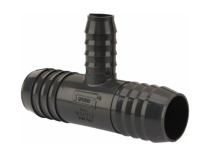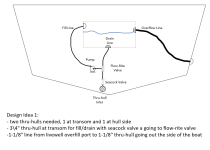SlipperyOar
Petty Officer 2nd Class
- Joined
- Apr 12, 2024
- Messages
- 141
I'm currently building an aluminum livewell to add into my boat, i'm going through what fittings i would all need and exploring my options.
There is the standard design (#1) with a thru-hull at the transom for fill and drain. This seems to be pretty common in the livewell plumbing systems i've seen. A seacock isolation valve installed right at the transom thru-hull, the tubed to the flow-rite valve to control whether water is emptying, filling, or recirculating. The livewell pump then leading to the top of the livewell. The drain port off the bottom leading back to the flow-rite valve to either be drained or recirculated. And then an overflow line slightly below the fill port level which will lead out the boat, routed to the starboard side just above the waterline.
The design i came up with, uses the same flow-rite valve, with the fill/drain/overflow lines all routed to the one transom thru-hull. A tee placed between the seacock isolation valve and the flow-rite valve. This system would be intended to fill the splashwell, recirculate water, and also overflow back through the tee and out the transom thru-hull. My idea behind the concept is to eliminate the need for a second thru-hull, therefore minimizing potential spots where water ingress is possible.
Has anyone ever plumbed up something similar with any feedback? I'm not particularily deciding based on the oxygen levels within my splashwell. More so just interested in the potential for proper water flow. Both livewell overflow ports are going to have threaded screens on them to allow water but act as a filter of sorts.



There is the standard design (#1) with a thru-hull at the transom for fill and drain. This seems to be pretty common in the livewell plumbing systems i've seen. A seacock isolation valve installed right at the transom thru-hull, the tubed to the flow-rite valve to control whether water is emptying, filling, or recirculating. The livewell pump then leading to the top of the livewell. The drain port off the bottom leading back to the flow-rite valve to either be drained or recirculated. And then an overflow line slightly below the fill port level which will lead out the boat, routed to the starboard side just above the waterline.
The design i came up with, uses the same flow-rite valve, with the fill/drain/overflow lines all routed to the one transom thru-hull. A tee placed between the seacock isolation valve and the flow-rite valve. This system would be intended to fill the splashwell, recirculate water, and also overflow back through the tee and out the transom thru-hull. My idea behind the concept is to eliminate the need for a second thru-hull, therefore minimizing potential spots where water ingress is possible.
Has anyone ever plumbed up something similar with any feedback? I'm not particularily deciding based on the oxygen levels within my splashwell. More so just interested in the potential for proper water flow. Both livewell overflow ports are going to have threaded screens on them to allow water but act as a filter of sorts.






















